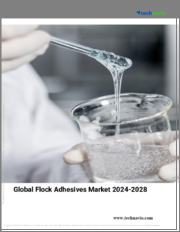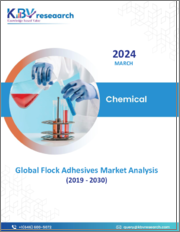
|
시장보고서
상품코드
1394209
세계의 플록 접착제 시장 평가 : 수지 유형별, 도포 기재별, 최종 이용 산업별, 지역별, 기회, 예측(2016-2030년)Flock Adhesives Market Assessment, By Resin Type, By Application Substrates, By End-use Industry, By Region, Opportunities and Forecast, 2016-2030F |
||||||
세계의 플록 접착제(Flock Adhesives) 시장 규모는 2022년의 24억 달러에서 2023-2030년에 39억 달러에 달할 것으로 예상되며, 2030년 까지 예측 기간 동안 CAGR로 6.5%로 추이하며 성장 할 것으로 전망되고 있습니다.
자동차 산업은 이러한 접착제의 주요 소비자이며, 그 성장이 인테리어 트림 및 인테리어와 같은 용도에 사용되는 플록 접착제에 대한 요구와 직접 관련되기 때문에 수요에 상당한 영향을 미칩니다. 동시에 의류, 가구, 기술 섬유의 제조를 포함한 섬유 산업은 시각적 매력과 기능성을 함께 강화하는 플록 접착제에 의존합니다. 또한, 급성장하는 아시아 시장은 제조 및 산업 활동의 확대에 따라 플록 접착제의 이용 증가에 특히 기여하고 있습니다.
게다가, 접착 기술의 혁신과 지속 가능한 접착제의 배합의 중요성은 플록 접착 시장을 형성하는데 매우 중요합니다. 또한 소비자 선호 변화, 맞춤형 솔루션 추구, 제품의 수명 연장에 대한 흔들림 없는 고집이 다양한 용도에서 플록 접착제 수요를 더욱 밀어 올리고, 플록 접착제는 많은 산업에서 다용도 그리고 필수적인 구성 요소입니다.
자동차 산업의 강한 수요는 플록 접착제 수요를 증가
플록 접착제는 자동차 산업, 특히 대시보드 패널, 도어 패널, 헤드 라이너, 시트 등 다양한 인테리어 부품의 제조에 중요한 역할을 합니다.
예를 들어, 2023년 9월 인도 자동차의 총 판매량은 전년 대비 20% 증가하고 현저한 성장을 보였습니다. 이러한 세계 자동차 산업의 견조한 성과로 플록 접착제 수요가 높아지고 있습니다.
전자기기 생산 증가로 플록 접착제 수요 증가
예를 들어 일본 정부는 반도체 칩의 국내 생산 강화를 목적으로 한 이니셔티브에 2022년 말까지 5억 1,000만 달러를 할당했습니다. 미국, 일본, 한국 등 여러 국가가 국내 생산을 늘리고 있으며, 이는 세계의 플록 접착제 수요를 높이고 있습니다.
기술 섬유의 안정적인 수요가 플록 접착제 시장을 견인
예를 들어, Freudenberg Performance Materials는 2023년 6월 기술 부문의 특정 포장 요구 사항을 충족하도록 설계된 최첨단 재사용 가능한 직물 컨테이너를 발표했습니다. 기술 섬유의 지속적인 개발과 투자는 플록 접착제 수요를 세계적으로 향상시킬 것으로 예상됩니다.
COVID-19의 영향
COVID-19의 유통은 공급망의 혼란, 잠재적인 공급 부족, 유통 중 경영 비용 증가로 인해 플록 접착제 시장을 혼란시켰습니다. 자동차와 섬유 등의 산업에서는 경영 정지에 의한 생산 감소가 보였고, 건설 부문에서는 프로젝트의 지연이나 캔슬이 발생했기 때문에 복수의 최종 이용 산업에서 플록 접착제 수요가 감소했습니다. 유행 기간 동안 PPE와 같은 기술 섬유 수요가 왕성했음에도 불구하고 플록 접착제에 대한 투자는 연기되었고 소비도 감소했습니다.
주요 전망
인쇄 및 포장 부문에서 플록 접착제 채택 증가는 세계적으로 플록 접착제 수요 성장을 향상시킵니다.
한국의 산업통상자원부는 2023년 3월 2042년까지 서울 근교 경기도 용인시에 첨단 반도체 전용 산업단지를 건설한다고 발표했습니다. 이 대규모 개발은 총 2,280억 달러에 달하는 민간 대규모 투자로 실현될 예정입니다. 이러한 반도체 프로젝트는 세계적으로 증가하고 있으며, 플록 접착제 수요가 증가하고 있습니다.
주요 기업 현황과 전망
플록 접착제 산업의 주요 제조업체는 기업의 지속가능성 목표에 부합하는 친환경 접착제 솔루션을 적극적으로 도입하여 고객에게 친환경 접착제 옵션을 제공합니다.
예를 들어, 2021년 7월, HB Fuller Company는 Covestro와 전략적 제휴를 맺었으며, 이는 환경 실적를 줄인 접착제 솔루션을 도입하기 위한 것입니다. 이러한 협업은 목공, 복합재, 섬유, 자동차 등의 부문의 요구에 부응하는 것으로, 동사는 보다 환경에 배려한 지속 가능한 접착제 제품을 세상에 내보낼 수 있습니다.
세계의 플록 접착제(Flock Adhesives) 시장에 대해 조사 분석했으며, 시장 규모 및 예측/시장 역학/주요 기업 현황 및 전망 등을 제공합니다.
목차
제1장 조사 방법
제2장 프로젝트 범위 및 정의
제3장 세계의 플록 접착제 시장에 대한 COVID-19의 영향
제4장 주요 요약
제5장 고객의 목소리
- 시장 인지도와 제품 정보
- 브랜드 인지도와 충성도
- 구매 결정에서 고려되는 요소
- 구매 빈도
- 구입 매체
제6장 세계의 플록 접착제 시장 전망(2016-2030년)
- 시장 규모 및 예측
- 금액
- 수량
- 수지 유형별
- 폴리우레탄
- 아크릴
- 에폭시
- 에틸렌 비닐 아세테이트(EVA)
- 기타
- 도포 기재별
- 패브릭
- 플라스틱
- 금속
- 유리
- 목재
- 기타
- 최종 이용 산업별
- 자동차
- 테크니컬 텍스타일, 의류
- 전기, 전자
- 종이, 포장
- 기타
- 지역별
- 북미
- 유럽
- 남미
- 아시아태평양
- 중동 및 아프리카
- 시장 점유율 : 기업별(2022년)
제7장 세계의 플록 접착제 시장 전망 : 지역별(2016-2030년)
- 북미
- 시장 규모 및 예측
- 수지 유형별
- 도포 기재별
- 최종 이용 산업별
- 미국
- 캐나다
- 멕시코
- 유럽
- 독일
- 프랑스
- 이탈리아
- 영국
- 러시아
- 네덜란드
- 스페인
- 터키
- 폴란드
- 남미
- 브라질
- 아르헨티나
- 아시아태평양
- 인도
- 중국
- 일본
- 호주
- 베트남
- 한국
- 인도네시아
- 필리핀
- 중동 및 아프리카
- 사우디아라비아
- 아랍에미리트(UAE)
- 남아프리카공화국
제8장 공급측 분석
- 생산 능력 : 기업별
- 생산 : 기업별
- 운영 효율 : 기업별
- 주요 공장의 소재지(최대 25사)
제9장 시장 매핑(2022년)
- 수지 유형별
- 도포 기재별
- 최종 이용 산업별
- 지역별
제10장 거시적 환경 및 산업 구조
- 수급 분석
- 수출입 분석
- 공급/가치 사슬 분석
- PESTEL 분석
- Porter's Five Forces 분석
제11장 시장 역학
- 성장 촉진 요인
- 성장 억제 요인(과제, 성장 억제 요인)
제12장 주요 기업 정세
- 시장 리더 상위 5개사의 경쟁 매트릭스
- 시장 리더 상위 5개사 시장 수익 분석(2022년)
- 인수 및 합병/합작사업(해당하는 경우)
- SWOT 분석(시장 참가 기업 5사)
- 특허 분석(해당하는 경우)
제13장 가격 분석
제14장 사례 연구
제15장 주요 기업 전망
- Sika AG
- Henkel AG&Co. KGaA
- HB Fuller Company
- Arkema SA
- Stahl Holdings BV
- NANPAO RESINS CHEMICAL GROUP
- Kissel Wolf GmbH
- PARKER HANNIFIN CORP
- Dow Inc.
- Permabond LLC
제16장 전략적 권장사항
제17장 당사에 대하여·면책사항
LYJ 23.12.15Global flock adhesives market size was valued at USD 2.4 billion in 2022, which is expected to grow to USD 3.9 billion in 2030 with a CAGR of 6.5% during the forecast period between 2023 and 2030. Flock adhesive is an essential component in various industries that involve bonding and flocking applications and are influenced by a range of key drivers.
The automotive sector is a major consumer of these adhesives and exerts a considerable influence on demand, as its growth directly correlates to the need for flock adhesives used in applications like interior trim and upholstery. Concurrently, the textile industry which includes the manufacturing of garments, furnishings, and technical textiles, relies on flock adhesives to augment both visual appeal and functionality. Moreover, the burgeoning market of Asia particularly contributes to the increasing utilization of flock adhesives as manufacturing and industrial activities expand.
Furthermore, innovation in adhesive technology and a growing emphasis on sustainable adhesive formulations are pivotal in shaping the flock adhesives market. Additionally, the shifting consumer preferences along with the quest for customized solutions, and an unwavering focus on product longevity further fuel the demand for flock adhesives across different array of applications, making them a versatile and indispensable component in numerous industries.
Strong Demand from Automotive Sector to Raise the Requirement of Flock Adhesives
Flock adhesives play a vital role in the automotive industry, particularly in the manufacturing of various interior components like dashboard panels, door panels, headliners, and seats. Their primary function is to securely bond and attach flock fibers to a wide range of substrates, creating a soft, textured, and durable finish. Additionally, flock adhesives are engineered to withstand the rigors of the automotive environment, including exposure to temperature fluctuations, moisture, and wear and tear, and provides higher durability for the automotive.
For instance, in September 2023, there was a notable 20% year-on-year increase in the total sales of automobiles in India. This robust performance in the global automotive industry has led to a heightened demand for flock adhesives.
Rise in Production of Electronics to Increase the Demand for Flock Adhesives
Electromagnetic Interference (EMI) and Radio-Frequency Interference (RFI) can negatively impact the performance of electronic devices. Flock adhesives are used to create EMI/RFI shielding gaskets or seals. The flock material helps to create a conductive barrier that prevents unwanted electromagnetic interference and radio-frequency interference. Additionally, flock adhesives provide insulation and protection, helping to prevent short circuits and ensuring the proper functioning of electronic devices.
For instance, the Japanese government has allocated USD 510 million during the end of 2022 for initiatives aimed at bolstering the domestic production of semiconductor chips. Several countries such as the United States, Japan, and South Korea are increasing their domestic production, which, in turn, is heightening the global demand for flock adhesives.
Steady Demand for Technical Textile to Drive the Flock Adhesives Market
The textile industry relies significantly on flock adhesives, particularly for manufacturing a wide range of products, including garments, furnishings, decorative items, and technical textiles. These adhesives serve essential functions in flocking and bonding applications, contributing to the quality and aesthetics of the end products. Moreover, flock adhesives in technical textiles reinforce the materials' capabilities, making them suitable for demanding applications across industries such as automotive, aerospace, and healthcare.
For instance, in June 2023, Freudenberg Performance Materials unveiled a state-of-the-art reusable textile container designed to address specific packaging requirements in technical sectors. Ongoing developments and investments in technical textiles will improve the demand for flock adhesives globally.
Impact of COVID-19
The COVID-19 pandemic disrupted the flock adhesives market due to supply chain disruptions, potential shortages, and increased operational costs during the pandemic. Industries such as automotive and textile witnessed reduced production due to lockdowns, while the construction sector experienced project delays and cancellations, which led to decreased demand for flock adhesives across multiple end-use industries. It resulted in deferred investments and reduced consumption of flock adhesives, despite the strong demand for technical textile such as PPE during the pandemic.
Key Outlook
The rising adoption of flock adhesives in the printing and packaging sectors improves the demand growth for flock adhesives on a global scale.
The South Korean Ministry of Trade, Industry, and Energy announced in March 2023 that an upcoming industrial complex dedicated to advanced semiconductors will take shape in Yongin, located in the Gyeonggi Province near Seoul, by the year 2042. This significant development is set to be realized through substantial private-sector investments totaling USD 228 billion. Semiconductor project projects like these are increasing globally, increasing the demand for flock adhesives.
Key Players Landscape and Outlook
Prominent manufacturers in the flock adhesives industry are actively introducing environmentally friendly adhesive solutions that align with their corporate sustainability objectives along with offering eco-conscious adhesive options to their clientele, which is increasingly valuing sustainability as a key factor in their purchasing decisions.
For instance, in July 2021, H.B. Fuller Company formed a strategic alliance with Covestro, intending to introduce an adhesive solution with a diminished environmental footprint. Collaborative efforts like these cater to the needs of sectors such as woodworking, composites, textiles, and automotive, allowing the company to bring forth adhesive products that are more ecologically responsible and sustainable.
Table of Contents
1. Research Methodology
2. Project Scope & Definitions
3. Impact of COVID-19 on Global Flock Adhesives Market
4. Executive Summary
5. Voice of Customer
- 5.1. Market Awareness and Product Information
- 5.2. Brand Awareness and Loyalty
- 5.3. Factors Considered in Purchase Decision
- 5.3.1. Brand Name
- 5.3.2. Quality
- 5.3.3. Quantity
- 5.3.4. Price
- 5.3.5. Product Specification
- 5.3.6. Application Specification
- 5.3.7. VOC/Toxicity Content
- 5.3.8. Availability of Product
- 5.4. Frequency of Purchase
- 5.5. Medium of Purchase
6. Global Flock Adhesives Market Outlook, 2016-2030F
- 6.1. Market Size & Forecast
- 6.1.1. By Value
- 6.1.2. By Volume
- 6.2. By Resin Type
- 6.2.1. Polyurethane
- 6.2.2. Acrylic
- 6.2.3. Epoxy
- 6.2.4. Ethylene Vinyl Acetate (EVA)
- 6.2.5. Others
- 6.3. By Application Substrates
- 6.3.1. Fabrics
- 6.3.2. Plastic
- 6.3.3. Metal
- 6.3.4. Glass
- 6.3.5. Wood
- 6.3.6. Others
- 6.4. By End-use Industry
- 6.4.1. Automotive
- 6.4.1.1. Passenger Cars
- 6.4.1.2. Light-Commercial Vehicles
- 6.4.1.3. Heavy-Commercial Vehicles
- 6.4.2. Technical Textile and Clothing
- 6.4.3. Electrical and Electronics
- 6.4.3.1. Consumer Electronics
- 6.4.3.2. Appliances
- 6.4.3.3. Semiconductors
- 6.4.3.4. Others
- 6.4.4. Paper and Packaging
- 6.4.5. Others
- 6.4.1. Automotive
- 6.5. By Region
- 6.5.1. North America
- 6.5.2. Europe
- 6.5.3. South America
- 6.5.4. Asia-Pacific
- 6.5.5. Middle East and Africa
- 6.6. By Company Market Share (%), 2022
7. Global Flock Adhesives Market Outlook, By Region, 2016-2030F
- 7.1. North America*
- 7.1.1. Market Size & Forecast
- 7.1.1.1. By Value
- 7.1.1.2. By Volume
- 7.1.2. By Resin Type
- 7.1.2.1. Polyurethane
- 7.1.2.2. Acrylic
- 7.1.2.3. Epoxy
- 7.1.2.4. Ethylene Vinyl Acetate (EVA)
- 7.1.2.5. Others
- 7.1.3. By Application Substrates
- 7.1.3.1. Fabrics
- 7.1.3.2. Plastic
- 7.1.3.3. Metal
- 7.1.3.4. Glass
- 7.1.3.5. Wood
- 7.1.3.6. Others
- 7.1.4. By End-use Industry
- 7.1.4.1. Automotive
- 7.1.4.1.1. Passenger Cars
- 7.1.4.1.2. Light-Commercial Vehicles
- 7.1.4.1.3. Heavy-Commercial Vehicles
- 7.1.4.2. Technical Textile and Clothing
- 7.1.4.3. Electrical and Electronics
- 7.1.4.3.1. Consumer Electronics
- 7.1.4.3.2. Appliances
- 7.1.4.3.3. Semiconductors
- 7.1.4.3.4. Others
- 7.1.4.4. Paper and Packaging
- 7.1.4.5. Others
- 7.1.5. United States*
- 7.1.5.1. Market Size & Forecast
- 7.1.5.1.1. By Value
- 7.1.5.1.2. By Volume
- 7.1.5.2. By Resin Type
- 7.1.5.2.1. Polyurethane
- 7.1.5.2.2. Acrylic
- 7.1.5.2.3. Epoxy
- 7.1.5.2.4. Ethylene Vinyl Acetate (EVA)
- 7.1.5.2.5. Others
- 7.1.5.3. By Application Substrates
- 7.1.5.3.1. Fabrics
- 7.1.5.3.2. Plastic
- 7.1.5.3.3. Metal
- 7.1.5.3.4. Glass
- 7.1.5.3.5. Wood
- 7.1.5.3.6. Others
- 7.1.5.4. By End-use Industry
- 7.1.5.4.1. Automotive
- 7.1.5.4.1.1. Passenger Cars
- 7.1.5.4.1.2. Light-Commercial Vehicles
- 7.1.5.4.1.3. Heavy-Commercial Vehicles
- 7.1.5.4.2. Technical Textile and Clothing
- 7.1.5.4.3. Electrical and Electronics
- 7.1.5.4.3.1. Consumer Electronics
- 7.1.5.4.3.2. Appliances
- 7.1.5.4.3.3. Semiconductors
- 7.1.5.4.3.4. Others
- 7.1.5.4.4. Paper and Packaging
- 7.1.5.4.5. Others
- 7.1.6. Canada
- 7.1.7. Mexico
- 7.1.1. Market Size & Forecast
All segments will be provided for all regions and countries covered:
- 7.2. Europe
- 7.2.1. Germany
- 7.2.2. France
- 7.2.3. Italy
- 7.2.4. United Kingdom
- 7.2.5. Russia
- 7.2.6. Netherlands
- 7.2.7. Spain
- 7.2.8. Turkey
- 7.2.9. Poland
- 7.3. South America
- 7.3.1. Brazil
- 7.3.2. Argentina
- 7.4. Asia-Pacific
- 7.4.1. India
- 7.4.2. China
- 7.4.3. Japan
- 7.4.4. Australia
- 7.4.5. Vietnam
- 7.4.6. South Korea
- 7.4.7. Indonesia
- 7.4.8. Philippines
- 7.5. Middle East & Africa
- 7.5.1. Saudi Arabia
- 7.5.2. UAE
- 7.5.3. South Africa
8. Supply Side Analysis
- 8.1. Capacity, By Company
- 8.2. Production, By Company
- 8.3. Operating Efficiency, By Company
- 8.4. Key Plant Locations (Up to 25)
9. Market Mapping, 2022
- 9.1. By Resin Type
- 9.2. By Application Substrates
- 9.3. By End-use Industry
- 9.4. By Region
10. Macro Environment and Industry Structure
- 10.1. Supply Demand Analysis
- 10.2. Import Export Analysis
- 10.3. Supply/Value Chain Analysis
- 10.4. PESTEL Analysis
- 10.4.1. Political Factors
- 10.4.2. Economic System
- 10.4.3. Social Implications
- 10.4.4. Technological Advancements
- 10.4.5. Environmental Impacts
- 10.4.6. Legal Compliances and Regulatory Policies (Statutory Bodies Included)
- 10.5. Porter's Five Forces Analysis
- 10.5.1. Supplier Power
- 10.5.2. Buyer Power
- 10.5.3. Substitution Threat
- 10.5.4. Threat from New Entrant
- 10.5.5. Competitive Rivalry
11. Market Dynamics
- 11.1. Growth Drivers
- 11.2. Growth Inhibitors (Challenges, Restraints)
12. Key Players Landscape
- 12.1. Competition Matrix of Top Five Market Leaders
- 12.2. Market Revenue Analysis of Top Five Market Leaders (in %, 2022)
- 12.3. Mergers and Acquisitions/Joint Ventures (If Applicable)
- 12.4. SWOT Analysis (For Five Market Players)
- 12.5. Patent Analysis (If Applicable)
13. Pricing Analysis
14. Case Studies
15. Key Players Outlook
- 15.1. Sika AG
- 15.1.1. Company Details
- 15.1.2. Key Management Personnel
- 15.1.3. Products & Services
- 15.1.4. Financials (As reported)
- 15.1.5. Key Market Focus & Geographical Presence
- 15.1.6. Recent Developments
- 15.2. Henkel AG & Co. KGaA
- 15.3. H.B. Fuller Company
- 15.4. Arkema SA
- 15.5. Stahl Holdings B.V
- 15.6. NANPAO RESINS CHEMICAL GROUP
- 15.7. Kissel + Wolf GmbH
- 15.8. PARKER HANNIFIN CORP
- 15.9. Dow Inc.
- 15.10. Permabond LLC
Companies mentioned above DO NOT hold any order as per market share and can be changed as per information available during research work.

















